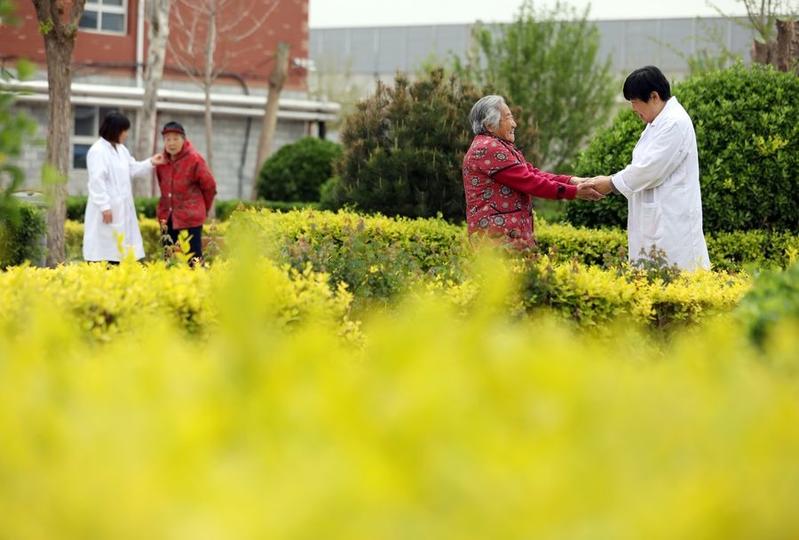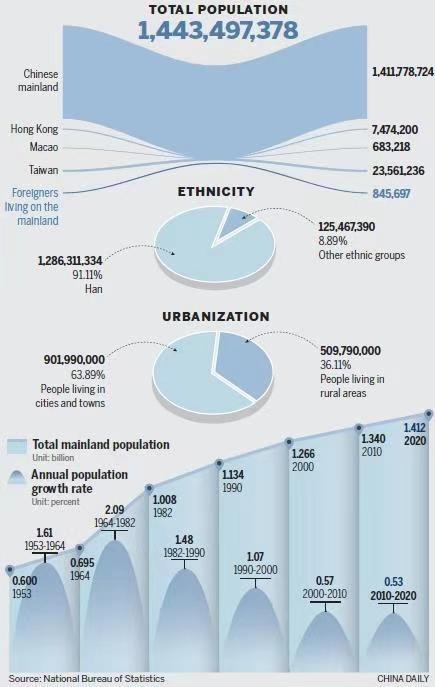 Elderly citizens are accompanied by medical care personnel at an elder care center in Taocheng district of Hengshui City, north China's Hebei province, May 5, 2019. (MU YU / XINHUA)
Elderly citizens are accompanied by medical care personnel at an elder care center in Taocheng district of Hengshui City, north China's Hebei province, May 5, 2019. (MU YU / XINHUA)
Amid the slow growth of its total population to 1.44 billion, China has seen a sharp rise in older adults and an uptick in young people over the past decade, solidifying the country's rapidly aging pattern, the latest national census data show.
The population on the Chinese mainland increased by an average of 0.53 percent annually during the past 10 years to 1.41 billion, compared with an annual growth rate of 0.57 percent from 2000 to 2010, according to the seventh national census released on Tuesday by the National Bureau of Statistics.
"The growth of the total population has slowed down but remains at a steady pace," Ning Jizhe, head of the bureau, said at a news conference organized by the State Council Information Office.
Based on trends in recent years, China's population will grow at an increasingly slow rate in the future while remaining above 1.4 billion.
Ning Jizhe, Head of the National Bureau of Statistics
"Based on trends in recent years, China's population will grow at an increasingly slow rate in the future while remaining above 1.4 billion."
ALSO READ: Official data show China's population has touched 1.41b
The increasing elderly population has become a defining feature of the past decade. People age 60 or above account for 18.7 percent of the total population, up about 5.4 percentage points from the count a decade ago.
Ning said an aging society will set the tone for China's demographic structure for a long time, presenting challenges as well as opportunities.
"A graying population will pile pressure on provision of labor force and social services, as well as adding to families' elderly care burden. But more elderly people could also stimulate consumption of products and services targeting this age group, and advance the development of some technologies," he said.
Ning added that those between the ages of 60 and 69, who are equipped with knowledge, experience and skills and are generally in good health, make up nearly 56 percent of all older adults.
"The potential of them to continue making contributions to society and playing a constructive role is big," he said in response to a question on the outlook for raising the retirement age and implementing other potential measures aimed at addressing the aging trend.
Li Tongping, a population economist at China University of Geosciences in Wuhan, Hubei province, said the latest number and proportion of elderly are largely within predictions, and the aging trend will continue for a long time.
"It is notable that the ratio of elderly has surpassed that of children and teenagers for the first time in the once-in-a-decade census, underscoring the pressing need to relieve elderly care pressure falling on working-age adults," he said.
READ MORE: Population ages amid COVID-19

What came as a surprise to Li and some other experts is that the share of people age 14 or younger has grown by 1.35 percentage points to 17.95 percent, although birthrates have fallen in recent years, according to the census data.
The slight increase over the past decade is likely driven by the gradual relaxation of family planning policies, according to Ning, the NBS chief. China decided to allow all couples to have two children in late 2015.
A sign of the policy adjustment's outcome is that children born as a second child to a couple accounted for as much as 50 percent in 2017, and the figure has stayed above 40 percent in the past few years, Ning said.
However, the small increase does not obscure the looming threat of declining birthrates in China, experts and officials have said.
Ning said an estimated 12 million babies were born last year, down more than 2.6 million from 2019 and nearly 5.9 million from 2016, the year the universal second-child policy took effect.
"The latest census puts the fertility rate (the average number of children born to women) at 1.3, which is at a low level," he said, added that a decrease in women of childbearing age and low willingness to have children are among contributing factors.
READ MORE: Nation to improve population policy, experts say
China's fertility rate reached the replacement rate of 2.1 — the minimum threshold for keeping a stable population — in 1992 and has since entered an era of low fertility rates, according to experts.
Huang Kuangshi, a researcher at the China Population and Development Research Center, said current projections for the annual number of newborns in the next decade are "not very upbeat". This is likely to contribute to an overall population drop in the next few years.
"A fertility rate of 1.3 to 1.5 is expected to become a normal rate for quite a long time. Boosting the rate above 1.5 and higher will require particularly strong supporting policies that encourage couples to have children, as well as further upgrades of family planning policy," he said.
NBS chief Ning said a key development blueprint approved by the nation's top legislature earlier this year has stipulated that China will adopt a more inclusive family planning policy and alleviate pressure associated with giving birth and rearing children.
"Bureau data suggests that Chinese women of childbearing age are willing to have 1.8 children on average," he said. "More support policies could play a role in tapping the fertility potential."


